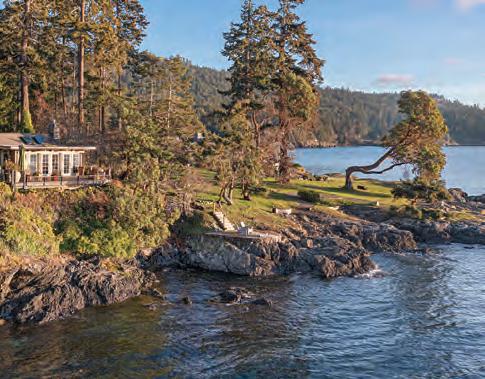
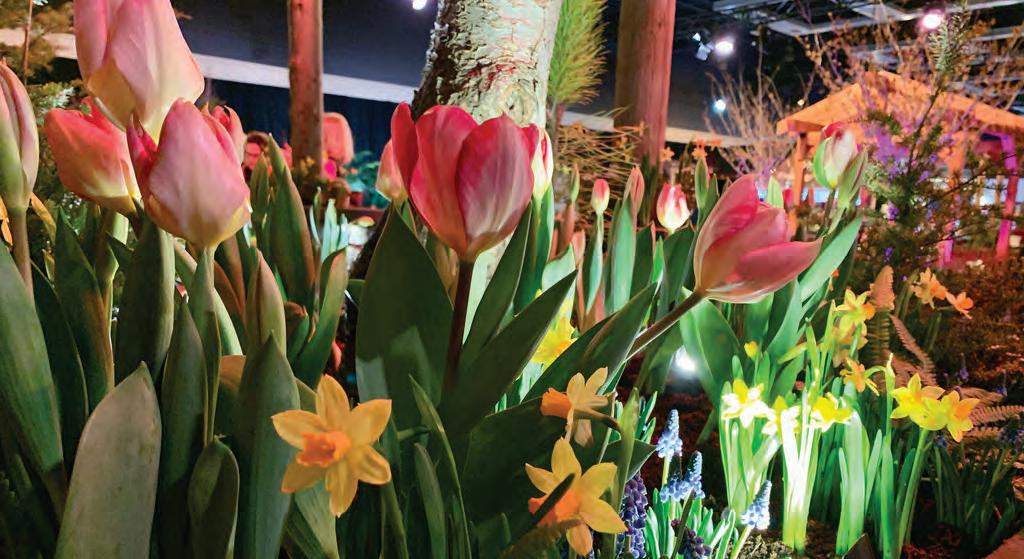



If you didn’t plant undulating carpets of snowdrops, crocus and early daffodils in September, not to worry. Didn’t force any bulbs inside? It’s OK, read on. You can still enjoy some microdoses of oh-so-welcome flower power right now.
Happily, growers around the region did the growing and forcing for you, and supermarkets, florists and nurseries are beginning to glow with cheerful spring bulbs in pots. From smallest to largest, you’ll find tiny snowdrops with their dangling bells, upward-facing crocus, fragrant hyacinths,

and narcissus (daffodils) from rock-garden-size “Tete a Tetes” to taller “February Gold” or “Thalia.” I love “Tete a Tetes” especially because they bloom for weeks and weeks, and their small size makes them easy to fit into borders without having to look at big gangly leaves after they bloom.
By Friends of Madison Park
Friends of Madison Park is hopping with plans for the spring and summer of 2025 and next steps with exploring a renovation of the Bathhouse and Beach area, and getting educated on the One Seattle Plan.
One Seattle Plan
There was a lively neighborhood meeting on February 4th delving into the One Seattle Plan and its impact in our neighborhood. Friends of Madison Park continues to gather information; the One Seattle Plan Committee walked the neighborhood with Joy Hollingsworth in February and reviewed the need for an adequate Environmental Impact Study of stormwater infrastructure in our neighborhood and pressed that the boundaries of the
proposed Neighborhood Center include the variety of housing available in the community along 43rd Ave E and E McGilvra.
In February, Friends of Madison Park also requested an appeal of the Final Environmental Impact Statement (FEIS) to the City Hearing Examiner and the outcome of that is still pending as of this publication. The next public City hearing on the One Seattle Plan is scheduled for April- though the date is not published yet. The City Council now is waiting for directions from the Mayor’s Office regarding lot coverage under HR110 and the Council will review the FEIS — once all Appeals have been heard.
Friends of Madison Park will have further updates at our next Neighborhood Meeting on Tuesday, March
4 at 7 p.m. at the Bathhouse. Renovation of the Bathhouse and Beach Restoration
Friends of Madison Park is moving onto the next steps to explore enhancements to our neighborhood Bathhouse, Beach area and park spaces.
Friends of the Park is our new neighborhood partnership with the Seattle Parks Department and the first work party is scheduled for Saturday, March 29 from 9 a.m. to noon. Parks department will provide community members with tools and training to have regular weeding, pruning, planting parties to improve and maintain the look of our community parks. Want to join in the fun? Reach out to volunteer@
Feel free to dig these, pots and all into your outdoor containers for a winter reboot. If you need more, you’ll see primroses available in every color, and some pansies, that make an excellent edgers around the bulbs. Other welcome supporting cast members would be perennials like hellebores and saxifrages, which will be blooming anon, which won’t need replacing next year.
There’s no reason you can’t fill an entire


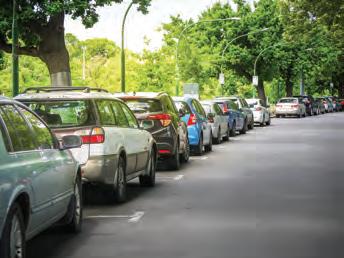



The first March I spent here there was so much rain.
One morning, as winter rain became spring rain, I lazed in bed wondering how I would do, what I would do, with all the hours ahead of me on a rainy day like this if I didn’t have my writing to see me through the hours?
Someone who goes for a long walk through the neighborhood first thing in the morning instead of a few short steps to her desk?
And without missing a beat, I thought, I’m going to take the day off.
Why not? Who cares? It doesn’t mean I’m getting lazy. I know what’s likely for me (one morning away from my desk) and what isn’t (two). I threw off the covers and ignored my laptop, so there.
In minutes I was on the sidewalk. I walked to the bakery.
And there in a booth to my left were two women talking.
Two women talking are three of my favorite words.Two women talking with a wandering yet focused determination; two women talking seriously who manage to belly laugh at the same time; two women talking and probably not remembering everything that was said when they get home, just that everything was, well, these women tie the loose ends of me to the rest of me.

I stood in line pretending not to listen. I listened.
Uneasy at first and then relieved to know I am not alone.
What are the odds of overhearing two women discuss a story so familiar? Because what one of the women said I know, and the next thing she said I know, and the rest of what she said, I know, I know, I know.
I faked a cough and stepped a little closer to the women.
In no time, I felt how much more fun it is to listen to a story about being so annoyed you are furious, than to be so annoyed you are furious. How much easier it is to listen to a woman trying to forgive herself than it is to forgive myself. Basically, this is what I heard: One woman said her husband hadn’t remembered to pick up their daughter after ballet class. Again.
Again. That was key.
She was mad. After slamming the door, she drove off and kept driving until she ended up at Trader Joe’s. I could see it. That store is definitely the perfect de-fuming
shopping spree destination. The wine aisle alone. I liked her story. Not the tension of it so much, as what the telling of it meant for the telling of mine. Still, I could have just grabbed my coffee and gone for a walk instead of back to my desk to write . . . this: I don’t know about you, but I don’t often get invited to a formal dinner party.
So.
I bought a new dress. I bought a new shirt for my husband, one that is not a long-sleeved Hurley Tshirt. I found a bottle of wine that looked more expensive than it was and a wine bag with little dogs on it because I know the hostess loves dogs. I put everything in a basket.
I put everything is a basket because my husband was to pick me up after a bike ride I wanted to fit in before the party so that I could have seconds, have more wine, have desert, have more desert. All my husband had to do was remember to bring the basket.
I placed the basket by the front door. The door he had to exit to get out. When we met me at our designated pick-up spot, I was still wearing a bathing suit under a gauzy shift and flip-flops. (I’d also stopped by the pool to swim my laps (because did I mention that the host made not one desert, but three?)
Oh no. Oh god. No.
Okay, I know you know what happens next. So did my sister. Who had the nerve to say, “It was really your fault. You should have put the basket in the car yourself.”
(I love you anyway, sis.)
The look on his face said it all. “Um, I forgot, sorry.” And nothing else. Wait. Shouldn’t he say more than nothing else? Shouldn’t he be sorry in a way that doesn’t sound like, ut oh, looks like I’m in the dog house. So I better say I’m sorry.
There was major traffic; no time to return home for the basket.
My husband was quiet in the car. I was not even remotely quiet in the car. I said something that finally made him say something that made me say something that made him even quieter.
But not sorrier.
Part of me thought how could I act this way with the person in this world I love the most? The other part was thinking, I have not forgiven you yet, buddy, not even close.
It wasn’t so much that I had to go to a fancy dinner in a beach cover-up, or that my husband made a mistake. Who doesn’t make a mistake? It’s that his apology triggered something in me I have trouble explaining to him. I wish his apologies sounded like he cared more about what he was actually apologizing for. That’s the thing he doesn’t seem to get. But no matter

From page 1
window box with spring bulbs for a fantastic display. Keep in mind, it will need changing out in a month or so.
ACCENTUATE SLEEPY SHRUBS
Sure, shrubby dogwoods may be shining right now, and their bright winter stems make great adds to winter containers and arrangements, but other deciduous shrubs may not be looking their snazziest at the moment. (How do you look when you’re sleeping?) If you have a front-andcenter hydrangea, ninebark (Physocarpus), or other sparse creature, why not add a skirt of bulbs at its feet? It won’t notice, and you’ll love the effect. This is a great location for permanent bulbs too.
MAKE A MASS
Get a collection of inexpensive terracotta pots or baskets to use as cachepots and display a curated field of bulbs anywhere you crave color – from your front steps to your dining table. The
uniform containers will unify your collection. Indoors, bulbs will probably finish blooming faster and will need to be planted outside ultimately.
Have you ever made a kokedama? The plant’s root ball and soil are rolled into balls and wrapped in sphagnum moss for hanging or table display. To secure the moss, you typically use green florist’s wire or clear picture hanging filament. They are especially charming hung from trees. I recently saw British gardener @ lady_green_fingers create adorable kokedamas with spring bulbs, which really brings the flowers into view.
With their roots so close to the air, kokedama plants can dry out more quickly, so be ready with a mister if rain is sketchy. You could also do this indoors temporarily but keep evenly moist.
Likewise, you can make lovely table arrangements using potted spring bulbs inside. Consider planting up a piece of bark or driftwood, or
how many times I’ve tried to explain this to him, his next apology sounds like, “Oh, gee, sorry.” This doesn’t excuse my anger but it does shed light on why my fuse has grown shorter.
At the party, everyone laughed at our “funny story.” On the way home, I don’t remember exactly what one of us said, maybe I told him what I’d read in another writer’s memoir, “we fight with our husbands so we won’t kill people,” but it was something that got us past the worst of us. And somehow we clicked back into place. I forgave him. I forgave me. I still haven’t worn my new dress. Maybe to next Art Walk. Whenever I think of this story, I am reminded how listening to others (if a little sneakily) helps us to better know ourselves, and I am happy to say that I am a firm believer in a serendipitous world.
Mary Lou Sanelli’s latest title is In So Many Words, nominated for a 2025 Washington State Book Award. A professional speaker and master dance teacher, she has written the “Falling Awake” column for Pacific Publishing’s Seattle newspapers for 17 years. For more information visit www. marylousanelli.com
From page 1 friendsofmadisonpark.com for more information.
FoMP is also now partnered with Seattle Parks Foundation, Seattle Parks Department, Anchor QEA landscape architects and Signal architectural firm to take next steps in exploring options for improvements to our neighborhood beach and Bathhouse. Look for open community meetings later in 2025 to discuss what our neighborhood would like to see be done to improve both the facility and the surrounding beach, park and dock on our waterfront. We want to gather as much input as possible during these sessions.
More Beautification in Madison Park
filling an urn, accessorized with lichen-covered branches and lots of moss. For inspiration, check out the work of florist Francoise Weeks (https:// francoiseweeks.com/).
Once your potted bulbs are done blooming, you can replant in the garden (without its pot), adding some bulb fertilizer scratched into the soil surface. I’m not recommending planting in the container permanently because getting bulbs to overwinter in containers can be tricky in our wet climate. Some bulbs are more likely to be perennial than others. Tulips are notoriously unpredictable, except for Darwin hybrids. Also, the bulbs may be tuckered out from being forced to bloom early, hence the bulb food. A return performance is not guaranteed, is what I’m saying. For best results, don’t trim the leaves – they help nourish the bulb to grow again another year. If you don’t have room for the bulbs, pass them along to a friend with a garden. If you’re ready for more garden inspo, check out my new Substack newsletter, A Gardener’s Path https://ericabrownegrivas.substack.com/.
Mark your Calendars for our Spring-Clean Up Day Saturday, May 3 from 9 a.m. to noon. Check in at the Bank of America table. Like last year’s Spring and Fall Clean-Ups, we will focus on the business district, weeding, sweeping and general clean-up to help our businesses to sparkle for the summertime. Also enjoy all our new daffodil bulbs coming up this spring under many of our street trees and planter boxes! Want to pitch in, sign up through volunteer@friendsofmadisonpark.com.
Easter Egg Hunt
Our Easter Egg Hunt comes early this year! Saturday, April 5 at the park from 10 a.m. to noon.

By Brett Davis
A recent survey by the Association of Washington Business shows cautious optimism among state employers, while a new study by WalletHub found that Washington employers aren’t struggling to find workers.
AWB’s most recent quarterly survey, based on 441 responses collected by email from business owners and operators across the state from Jan. 16 through Jan. 30, hints at a more upbeat take on the economy.
According to the survey, 17% of respondents expect a recession in Washington in the next year, down from a quarter who said that a year ago. Almost half of respondents were optimistic that their businesses would see growth in the next six months.
However, respondents also said their five biggest challenges are government regulations, the overall tax burden, inflation, the cost of health care and a lack of qualified workers.
The effects of the COVID-19 pandemic remain a concern as well, with 37% of respondents saying their business costs have gone
up 21% to 30% since January 2021. More than 75% said their business had experienced rising energy costs in the past two years.
Manufacturers and agricultural producers were asked about tariffs in light of President Donald Trump’s recent tariffs aimed at Canada, Mexico and China. Trump says these tariffs will boost the U.S. economy and protect it from illegal immigration and the flow of drugs.
More than half – 54% – of respondents said they were concerned that potential tariffs or retaliatory tariffs would negatively impact their business.
“Washington employers are feeling slightly more confident about their businesses in the coming year, but it’s clear that rising costs remain a major concern,” AWB President Kris Johnson said in a news release. “Employers need certainty and predictability. We urge the Legislature to find ways to support businesses and grow the economy this year and not add to years of skyrocketing costs by passing new taxes and regulation.”
There was some more good news on

Evergreen State’s economic front.
According to a new study by personal finance company WalletHub, Washington employers have the third-smallest hiring struggle in the U.S. Only California and Hawaii fared better than Washington.
To see where employers are having the most trouble hiring new workers, WalletHub compared all 50 states and the District of Columbia based on the rate of job openings for both the latest month –January – and the last 12 months.
The job openings rate in Washington during January was 3.8%, while the job openings rate in the past 12 months was 4.17%
“This suggests a relatively stable
workforce with low turnover, which allows businesses to focus on growth rather than constant rehiring,” WalletHub analyst Chip Lupo told The Center Square in an email. He went on to explain why Washington did so well in the survey.
“Washington’s high ranking reflects a better alignment between job openings and available talent, competitive wages, and strong economic conditions that help retain workers,” Lupo said. “While hiring remains a challenge in some sectors, Washington’s labor market dynamics provide it with a competitive advantage, making it easier for businesses to fill positions compared to most other states.”


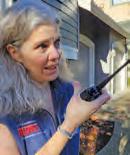
Dana Armstrong Emergency Prep
On the news, we’re used to seeing the U.S. emergency agency FEMA on site in a disaster, stacking sandbags and handing out food and water to affected folks. But what if those resources are unavailable—or if, as might happen during our long-expected “big one”—our neighborhood is inaccessible? Madison Street is the easiest way in and out of our neighborhood, but when it’s blocked, as you might have noticed during some of our icier days, our neighborhood basically shuts down. During an earthquake, emergency responders are unlikely to reach us right away.
We Madison Park Hub volunteers always assume the worst: that during a significant event, help from the government (even local government) is not coming quickly. Shortly after a disaster, if regular communications are disabled, we’ll set up our Hub — a community meeting place at the Madison Park tennis courts — to help our neighbors share skills and resources until help comes.
But where will the Hub’s skills and resources come from? They’ll need to come from us!
As highly interdependent people in a small but dense community, we should think about ways we can “prepare to prepare” before, during, and after a disaster. This article contains a few tips and suggestions, but I encourage you to think of other ways you might be able to help others before the “real” help arrives. Before a Disaster: prepare yourself, your home, and your family
The Seattle Office of Emergency Management (OEM) website includes essential easy-to-digest information for preparing for a disaster and is well worth a visit: www.seattle. gov/emergency-management/ prepare
Assembling an emergency kit — or at minimum storing some safe, drinkable water—is one of the easiest things you can do to prepare for the worst situations, and put yourself in a better position to help others. Per


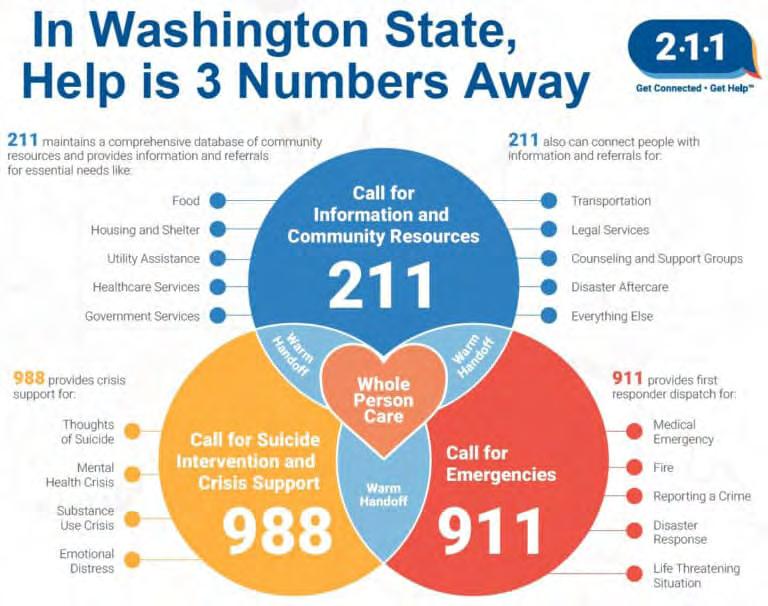
OEM’s “Prepare Yourself” page, a home preparedness kit should include items in these five basic categories:
■ Water
■ Food
■ Light Source
■ Warm & Dry Clothes
■ First Aid Kit
The OEM’s website also includes tips on how to shut off gas, water, and electricity (if needed), how to earthquakeproof your home, and much more. Be sure to check out its handy “Disaster Plan Template,” which you can print and fill out with key phone numbers, medical information, and other key details, like the locations of your closest fire station and police station—ideally to keep in your emergency kit for all of your family members to access.
Finally, note that Washington state has its own version of FEMA: our state’s Emergency Management Division, which is military-run, based in Tacoma, and designed to coordinate state emergency response with other agencies. You’ll find several useful preparedness resources, including videos, on its web page: mil.wa.gov/preparedness
During a Disaster: help others Serious earthquakes cause serious injuries, and responders might not be able to get to you to help. Consider learning vital life-saving skills to help yourself, your family, and your neighbors.
Someone who is severely bleeding can bleed to death “in as little as five minutes,” per the Stop the Bleed organization (part of the American College of Surgeons), which provides free one-hour classes on bleeding control. Stop the Bleed classes are available throughout the city,
with several offered not far from Madison Park in the next few months (March 13 at Montlake Community Center; April 12 at Garfield Community Center; May 13 at Miller Community Center); visit the OEM event calendar page to sign up: seattle. gov/emergency-management/ about-us/event-calendar
Stop the Bleed also has a short online training, if you have just thirty minutes to spare: www. stopthebleed.org/training/ online-course/
The American Red Cross offers inexpensive first aid and CPR classes both online and inperson. This year, I’m planning to take the Red Cross’ “Until Help Arrives” online class as well as its CPR class series (the first class is online, and then I’ll likely follow up with an in-person training to practice on their famous “dummies”). The Red Cross also offers more extensive first aid classes, including first aid for young children and pets. Visit www.redcross.org/local/ washington/take-a-class to see what local and online classes are available.
AFTER AN EMERGENCY: FIND RESOURCES
FEMA is tasked with helping people recover from disasters. But what similar resources do we have locally? I wanted to share a less-well-known one: Washington 211 Washington 211 is a free service that helps state residents connect with local services, including “utility assistance, food, housing, health, child care, after school programs, elder care, crisis intervention and more.” To access it, call 211 on your phone or text 211WAOD to 898211.
But did you know WA 211 is also “a reliable resource during times of crisis or disaster”? According to the WA 211 website (wa211.org), it provides an easyto-remember number to contact for “disaster-related resources, rumor control, and public health advisories.”
Specifically, per the website, WA 211 helps provide:
Non-Emergency Information: Provides updates on disaster status, evacuation routes, road closures, and shelter locations.
Community Coordination: Manages community donations and offers information on area reoccupations.
Alleviating 911 Overload: Reduces the load on 911 systems by handling non-emergency calls, which can surge above the typical 15-20% of all calls during disasters.
Disaster Recovery: Offers information and referrals to longterm assistance organizations and FEMA assistance.
Naturally, after an emergency where communications are affected, I encourage you to visit your neighborhood Hub near the Madison Park tennis courts to get or give help. Visit our web page at bit.ly/mphubsite for our latest news (and some useful resources).
As always, this column is part of Madison Park Emergency Hub’s outreach effort. We’re an all-volunteer org focused on neighbors helping each other after a disaster. We always need volunteers and ideas for new ways to prepare, and there are many roles to choose from. If you’d like to get involved with neighbors who want to help neighbors, it’s a light lift AND a lot of fun. Contact us at madparkhub@gmail.com with questions or to get on our mailing list. (And if you don’t want to type in all these links, please mail us for a link-filled PDF of this article!).
Washington Emergency Management Plan: Acts as a central contact point for emergency responders, volunteers, and donors during wildfires, landslides, severe weather, public health advisories, and man-made catastrophes. After an emergency, you can also visit Seattle.gov for the latest news and resources (I recommend you sign up for Alert Seattle text alerts, found at the bottom of the main page).
By Seattle Public Library
The Seattle Public Library, United Way of King County (UWKC) and AARP are collaborating to offer free, in-person tax preparation service through mid-April at 12 Library locations. The Library is offering free drop-in tax help with UWKC at two locations and with AARP at 10 more locations.
Trained volunteers can answer questions and help you prepare your personal tax return. This service is free and available to individuals only. The service is not available for business tax returns. See the list of eligibility requirements and required documents you need to bring at spl. org/TaxHelp. You can also find an updated list of Tax Help sessions on our Tax Help calendar.
In 2024, the Library hosted 251 Tax Help sessions, which helped taxpayers file 4,514 returns through the Library.
TAX HELP AT THE CENTRAL LIBRARY AND SOUTH PARK BRANCH
UWKC Tax Help serves anyone who earned less than $80,000 in 2024. Drop-in help is available on a first-come, first-served basis. The last client will be taken 30-45 minutes before the end of Tax Help hours.
Central Library, 1000 Fourth Ave., Level 5 (through April 19)
■ Mondays from 11 a.m. to 5 p.m.
■ Tuesdays through Thursdays from 12:30 p.m. to 6:30 p.m.
■ Saturdays and Sundays from 11 a.m. to 5 p.m.
South Park Branch, 8604 Eighth Ave. S. (through April 19)
■ Saturdays from 11 a.m. to 5 p.m.
■ Sundays from 11 a.m. to 5 p.m.
■ Spanish support provided upon request.
TAX HELP AT 10 OTHER LOCATIONS
AARP offers both drop-in assistance is available on a first-come, firstserved basis, and appointment-based assistance. Please note that you can make an appointment with AARP at their Tax Aide site.
Ballard Branch, 5614 22nd Ave. N.W. (through April 8)
■ Tuesdays from 11 a.m. to 3 p.m. (drop-in)
■ Broadview Branch, 12755 Greenwood Ave. N. (through April 14)
■ Mondays from noon to 3:30 p.m. (drop-in)
■ Wednesdays from 10 a.m. to 1:30 p.m. (drop-in)
Columbia Branch, 4721 Rainier Ave. S. (through April 11)
■ Fridays from 1 p.m. to 5 p.m. (appointment preferred)
Douglass–Truth Branch, 2300 E. Yesler Way, Seattle (through April 14)
■ Mondays from 12 p.m. to 4 p.m. (appointment preferred)
■ Saturdays from 12 p.m. to 4 p.m. (appointment preferred)
Greenwood Branch, 8016 Greenwood Ave. N. (through April 10)
■ Thursdays from 11 a.m. to 2:30 p.m. (drop-in)
NewHolly Branch, 7058 32nd Ave. S., Seattle (through April 12)
■ Saturdays from noon to 4 p.m. (appointment preferred)
Northeast Branch, 6801 35th Ave. N.E. (through April 12)
■ Saturdays from 11:30 a.m. to 3 p.m. (drop-in)
Queen Anne Branch, 400 W. Garfield St. (through April 13)
■ Sundays from 11 a.m. to 2:30 p.m. (drop-in)
Southwest Branch, 9010 35th Ave. S.W. (through April 11)
■ Fridays from 11 a.m. to 4 p.m. (appointment preferred)
West Seattle Branch, 2306 42nd Ave. S.W. (through April 12)
■ Thursdays from 1 p.m. to 4 p.m.
■ Saturdays from 11 a.m. to 3 p.m. (appointment preferred)
HOW
Most IRS forms, instructions and publications are available online at www.irs.gov. Due to federal budget cuts, the IRS is unable to provide the Library with certain tax forms and instruction booklets. To ask the IRS to mail you forms and instructions, order online at www.IRS.gov/ orderforms or call 1-800-829-3676.
You may make free black-and-white prints of the forms from Library computers: www.spl.org/Print
MORE INFORMATION
The Library believes that the power of knowledge improves people’s lives. We form strong partnerships with local communities to offer financial literacy and tax help events that serve our community. Check spl.org/hours for a complete list of hours and services at each branch. For up-to-date information on unexpected closures and schedule changes, the Library will update spl.org/Today. Contact the Library’s Ask Us service by phone at 206-386-4636 or by email or chat at spl.org/Ask. Staff are ready to answer questions and direct you to helpful resources and information.
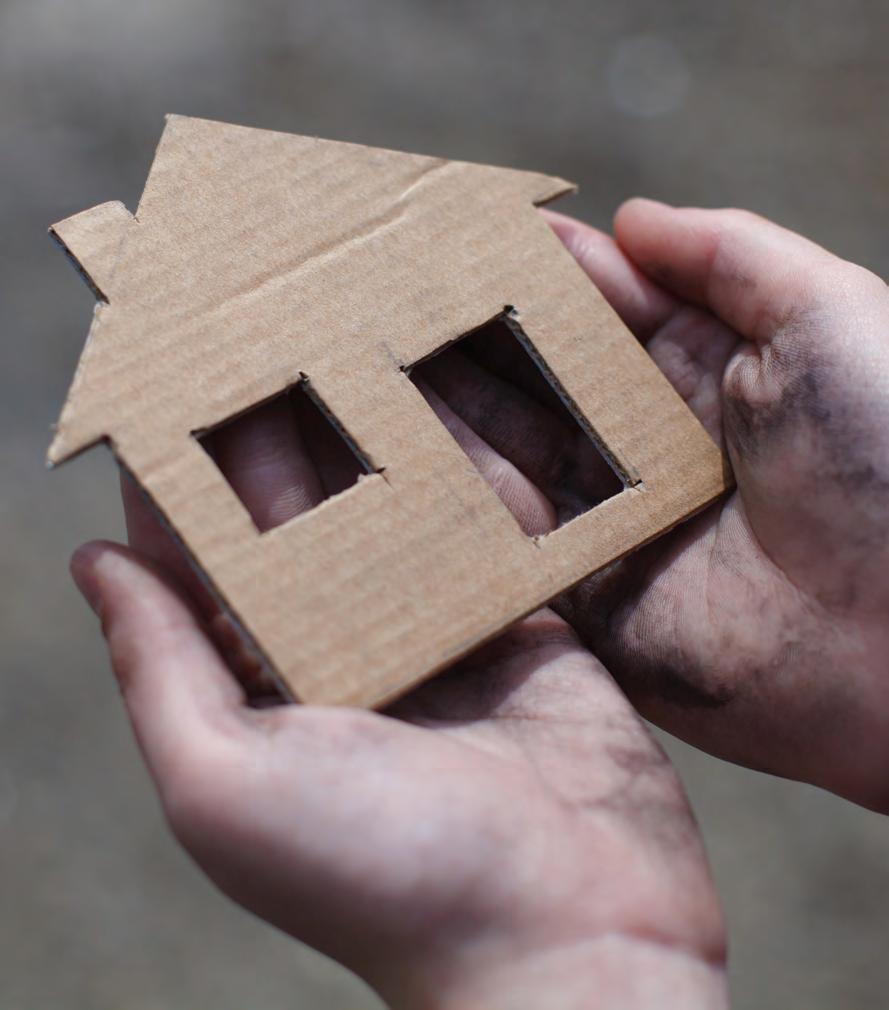
By Spencer Pauley | The Center Square
The King County Regional Homelessness Authority is working to adjust its funding model in order to stop ending the fiscal year with a negative cash balance.
The King County Regional Homelessness Authority Governing Board held its first meeting of 2025 on Thursday. Board members, which include leaders of King County and Seattle, were briefed on the agency’s funding model.
KCRHA starts off its fiscal year with zero dollars and works through a cost-basis model. This means it incurs expenses, pays for those expenses, and then can submit them for reimbursements.
The cost-basis model forces the agency into a negative cash position. This was flagged in a 2023 audit on KCRHA. That audit reported that the funding model places KCRHA’s current service levels and future obligations at risk.
The audit also identified a “significant timing gap” between when KCRHA pays its service providers and receives cash.
KCRHA’s bank balance sits within the King County Treasury Department as part of a pooled account. KCRHA Chief Financial Officer James Rouse explained to the Governing Board that the county allows the agency to go into the negative and through that process the agency is able to continue to reimburse its providers so that there is no delay in receiving allocated funding.
Because KCRHA consistently has negative cash balances, King County provides cash to the agency through an interfund loan.
KCRHA’s 2024 cash balance was negative for most of the year. There were two instances in the year when King County and Seattle provided the
agency with cash advances. The county provided $5.4 million in March 2024 and Seattle provided $29.1 million in July. The latter cash advance helped KRCHA get to a positive cash balance in August, but it soon became negative again in October.
For 2025, KCRHA projects a positive cash flow starting in March, with the end-of-year cash balance to end at $0 if KCRHA receives regular cash advances, according to Rouse.
According to Thursday’s presentation, KCRHA’s funding model only works with consistent cash advances. In order to maintain a positive cash balance, the agency said it will need to receive monthly cash advances from King County and Seattle.
Rouse said that the agency has been in constant talks with both the city and county to find a solution that alleviates a need for an interfund loan.
“We’re not there yet, but we’re getting close,” Rouse said during the board meeting.
There have been improvements in KCRHA’s financial workings. KCRHA CEO Kelly Kinnison told the Governing Board that as of last week, the agency was able to complete 98% of its contract renewals with service providers, totaling 193 contracts. That is compared to 45% done around this time in 2024, according to Kinnison.
The agency has also received and paid 99% of its 2024 provider invoices compared to 45% around this time last year.
Tracking of the agency’s spending is expected to improve after KCRHA recently transitioned to a new grants management system. On Jan. 27, KCRHA successfully launched its SalesForce Grants Management System, which Kinnison said will provide the agency with better data for tracking its contracts with service providers and budget information.

There’s something profoundly invigorating about plunging into cold water, whether it’s a brisk winter lake or a frigid alpine pool after a long summer hike. Cold dipping, the practice of immersing oneself in icy natural waters, is more than just a test of endurance — it’s a deeply rewarding experience that blends exhilaration, health benefits, and the simple joy of being in nature.
A GLOBAL TRADITION
For centuries, Nordic and Eastern European cultures have embraced cold plunges for their physical and mental benefits. In Finland, jumping into an icy lake after a sauna is a national tradition, known to enhance circulation and mental clarity. In Russia, winter swimming—often associated with Epiphany celebrations—has long been believed to boost immunity. Countries including Sweden,

Norway, and Estonia also have thriving cold-dipping traditions, often combined with sauna rituals. Beyond the Nordic regions, cold dipping is practiced worldwide. Himalayan yogis bathe in sacred rivers to strengthen the mind and body. The Maori of New Zealand engage in Wai tapu (sacred water) cleansing ceremonies, using cold water for healing and renewal.
The Ojibwe people incorporate cold plunges into vision quests and spiritual rituals, while the Inuit use them to build resilience against harsh climates.
The cold dipping tradition is taking off here in Seattle as well.
Fortunately for Seattleites, water abounds. In the depths of winter a cold dip is never more than a few miles away, as both Lake Washington and the Puget Sound descend to around 46 degrees Fahrenheit.
Recently on sunny weekend winter days I’ve been wading into Lake Washington with a friend, consistently running into handfuls of regulars there doing the same, all radiating an infectious ebullience and sparkle. The post-dip shine is impossible to miss and it stays with you for hours, days, weeks.
More organized Seattle groups have also solidified. The Coldwater Collective, for example, meets Sunday mornings at Alki for a sauna, plunge and potluck. The Seattle Open Water Swimmers — which has more of a swimming bent than a dip intention — meets regularly at the shores of chilly waters around Seattle including Golden Gardens, Myrtle Edwards Park, and more.

Athletes have long turned to cold water therapy to aid muscle recovery and reduce inflammation. Studies show that immersion in cold water can reduce soreness, decrease inflammatory markers, improve circulation, activate brown fat, increase metabolic rate, and improve insulin sensitivity, all potentially contributing to longterm benefits like better cardiovascular health and reduced chronic inflammation.
The cold causes blood vessels to constrict, flushing out waste products, and then reopen, delivering fresh oxygenated blood to tired muscles. Beyond the physical, cold dipping has remarkable mental health benefits. The shock of the cold triggers a flood of endorphins and dopamine, reducing stress. Further, it promotes mental resilience, by training the nervous system to remain calm under discomfort. Regular cold exposure has been linked to improved mood and reduced anxiety.
While cold dipping is invigorating, it’s essential to approach it with caution, especially in extreme temperatures. Here are some key safety tips:
Check with your Doctor: If you have a heart or circulation condition or are unsure whether it’s a good fit for you, check with your doctor first.
Acclimate Gradually: If you’re new to cold water immersion, start with short dips of just a minute or two and gradually increase exposure over weeks.
Know Your Limits: Cold water can cause shock and rapid breathing — stay in control and listen to your body. If you can’t maintain a steady, rhythmic breath, it is time to leave. If you feel numbness, dizziness, or confusion, exit immediately.
Swim with Others: Never cold dip alone. Being with friends ensures safety and enhances the shared experience.
Record LP’s/45’s, CD’s, Reel to Reel, 8 Track, Cassette Tapes. Call 206-499-5307

Bonded, and



Integrating intentional breath awareness into the dip elevates the experience and the health benefits. Practicing deep, rhythmic breathing before and during a cold dip helps override the body’s fight-orflight response, making it easier to enter and stay in the water longer.
The combination of cold exposure and breathwork leads to an almost meditative state — a moment of pure clarity where all that exists is your body, your breath, and the water around you.
Cold dipping isn’t just about health — it’s about the joy and the adventure. Imagine standing at the edge of a mountain lake after an arduous high-elevation hike, the crisp mountain air tantalizing your skin. You take a deep breath, brace yourself, and walk (or dive!) on in. The shock of the cold is immediate, but strangely inviting. Then comes a wave of vitality and an unmistakable sense of being alive.
My personal pinnacle cold dipping practice involves the interplay of hot and cold. And I’m not alone. Cultures the world over have honored the sauna-followed-by-colddip ritual. My highlight involves hiking to remote natural hot springs and alternating between soaking in the thermal waters and dipping into the inanely cold pools and rivers, routinely finishing with the cold. The experience evokes a simultaneous revitalization of spirit and a sense of deep mental and physical steadiness, calm, and resilience that lasts.
Wade, Rather than Jump: Wading enables the body to gradually adjust to the cold so your system doesn’t go into shock.
Warm Up Properly Afterward: Have dry clothes, a towel, and a warm drink ready. Avoid jumping straight into hot showers, as this can cause sudden blood pressure drops.
Be Aware of Hypothermia Risks: Watch for symptoms like shivering, slurred speech, or extreme fatigue. If someone is struggling, help them warm up gradually.
One of the greatest joys of cold dipping is the shared experience. Whether it’s a remote alpine lake, a winter river, Madison Park Beach, diving in with friends creates a sense of camaraderie that’s hard to replicate elsewhere. The shared challenge, the laughter, and the exhilaration of overcoming the initial shock together forge lasting memories and deeper connections. So next time you’re near a cold body of water, take the plunge (or perhaps better yet, wade in slowly). And of course, the most significant benefits stem from creating a consistent practice of it — perhaps your new Sunday morning routine! Your body, mind, and spirit will thank you.
Annie Lindberg is a licensed acupuncturist, Chinese Medicine practitioner, and Ayurvedic practitioner. She also holds a Masters of Environmental Studies. She owns and practices at The Point Acupuncture & Ayurveda, located in Madison Park and is a regular Madison Park Times health columnist.
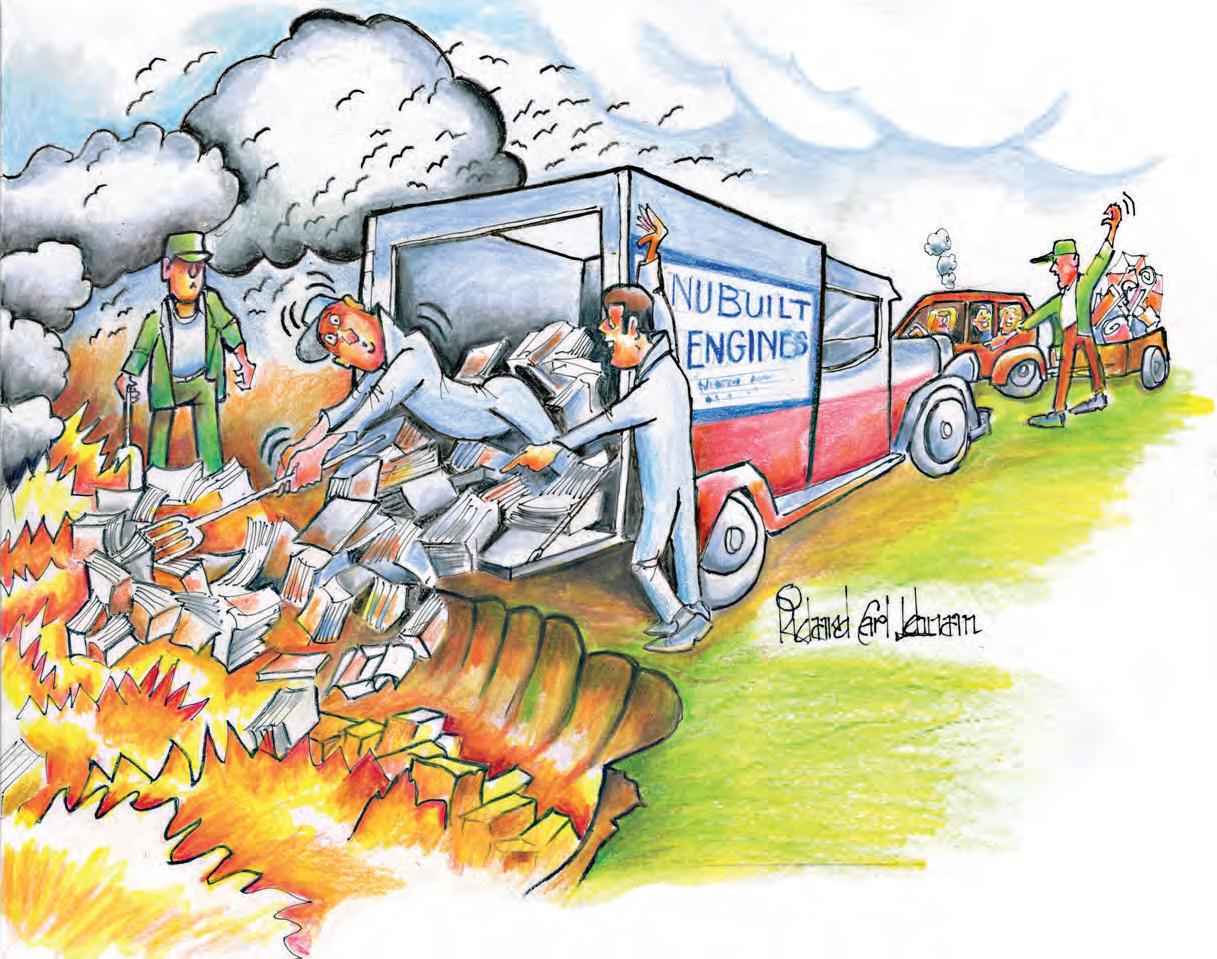
In the 1930s, Riverton Heights was a closeknit, modest community wrapped in comforting familiarity — a simplicity infused with resilience during the Great Depression. Neighbors knew each other by name, and everyone looked out for one another. We kids wore handme-downs or overalls; the only visible wealth came from watching Mickey Rooney movies that showcased his fancy clothes. The local general store served as a hub of activity, providing everything from essential food items to farming tools. It’s amusing how similar that general store was to Bert’s IGA and Madison Park Hardware stores.
Many residents of Riverton Heights were farmers, while others were employed in small, locally owned businesses. My dad worked in circulation at the Seattle Star newspaper every weekday and drove a 1930s Buick four-door to deliver bundles of newspapers to newsstands across Seattle.
As a preteen, I was captivated by the world. My friends and I found every car trip thrilling. We accompanied my parents to
dig rich, dark soil from Angle Lake for our garden. Later, we enjoyed a perfect picnic. A memorable adventure included taking friends to a dump south of Riverton Heights. During the Depression, you could often see people in need rummaging through the refuse before heading home. They sorted through clothing in the pit below, searching for anything of value. People awkwardly backed up their cars and trailers, with the women driving and the men standing like army sergeants, shouting commands.
Garbage was more relentless back then than it is today. Some people filled “onion” bags, rowed a short distance from shore, tossed them overboard, and watched them sink immediately. In Madison Park, the houseboat community often discarded their waste off the docks. When I started scuba diving in the 1950s, I discovered numerous items, including antiques and old medicine bottles, some with cork tops. One diver found a leather pouch containing 20 $10 double eagle coins.
The demand for the Seattle Dump, also referred to as the Montlake disposal site, Ravenna Dump, Union Bay Dump, and University Dump, was on the rise. Residents from Madison Park drove north past the site of what is now Husky
Stadium, where the odor from the dump made it unmistakably noticeable.
There were designated areas for large items, general waste, and items intended for burning. It resembled an oversized version of the dump near Riverton Heights.
One scene that could have easily made it onto America’s Funniest Home Videos featured a car and a small trailer backing up to the edge. The wife gripped the steering wheel tightly while her tall husband directed her with a supposed sense of love and care. Not quite. Everyone watched as he flaunted his machismo. He shouted, “Go right, go left, no, the other left!” while onlookers laughed and looked away. She squeezed between a few cars, but he took control of the wheel, exerting all his effort into it.
When I worked at Stan Sayres, Inc., a Chrysler dealership located at Broadway and Madison (now Whole Foods) in the late 1950s, one of my responsibilities was taking inventory of Rolls-Royce engines for the Slo-Mo 4 hydroplane, as well as Allison and Merlin engines. We exchanged leased space in the basement of the Davis and Hoffman Auto Repair Company to dispose of refuse.
Along with office paper and other waste from the Stan
dealership, we consistently had a full load.
The task was added to a schedule for individuals to take turns driving the large truck to the dump. It was rumored that the chosen person would linger there, hoping to discover a treasure for their home. One day, one of the guys put on his bright white overalls for the trip and was warned, “Just make sure you don’t fall into the fire pit!”
Later, we learned that this employee had been pushing a stack of papers from the truck with a pitchfork when he lost his balance. He took the pitchfork and his papers with him as he flew into the fire pit.
A friend reported never having seen anyone run through fire like that. He escaped with singed eyebrows, a burned hairline, and crispy overalls but didn’t think to look for the pitchfork surrounded by flames. It was brand new.
One garbage disposal technique involved placing debris in old paint cans and tossing them into the fire pit. As the flames heated the cans, the lids would pop loudly and fly off in all directions. If the smell of the dump didn’t bother you, driving on it felt like quicksand as it floated on Lake Washington.
Lake Union became yet another dumping ground for old iceboxes that modern refrigerators
had replaced. Residents of houseboats would row out to 40 feet of water and abandon them under the cover of night. Scuba divers could easily find the iceboxes, and it was common to haul them up to the surface and resell them as antiques. Additionally, discarded halffull quart bottles of Everclear were found, still packing quite a punch!
The City of Seattle and the University began closing the landfill in 1965, completing the process in 1971. The area now supports such rich vegetation and wildlife that the University of Washington holds classes on wildlife and landscape architecture, and civil engineers use it as a laboratory.
Karen and her colleagues, all former flight attendants, plan to hike the trails at the Center for Urban Horticulture in May. During a previous visit, she and her friend discovered a fantastic spot for birdwatching. They observed a large crane flying nearby and another bird with a blue head, possibly from the Blue Jay family. This reminded her of the movie Jurassic Park. Additionally, she noticed a pipe emerging from the ground, which might indicate a mechanism for releasing and testing methane gas.




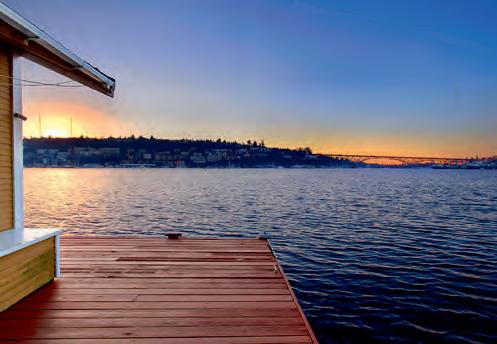








By Tim Clouser The Center Square
Washington state needs to build more than one million housing units over the next two decades, but one proposal intends to clear the way by repealing the state’s minimum parking requirements.
Spokane eliminated its parking requirements last year to encourage the development of empty lots around town. The Legislature wants to follow suit with Senate Bill 5184, but only for cities with more than 20,000 people, extending to roughly 60% of Washingtonians.
The proposal aims to bolster the state’s housing supply by lowering the amount of mandated parking developers must provide. Sen. Jessica Bateman, D-Olympia, said 58% of renters have one or no car, but building a home with less than
one space is illegal in most cities.
“The way that we regulate parking in the [U.S.] is getting in the way of our ability to create the things that we also need,” Bateman said. “We know that there are some places where it makes sense to have a lot of parking, and then there are other times when it’s not necessary.”
If approved, SB 5184 would prohibit cities from requiring more than 0.5 parking spaces per unit.
She argued that the current regulation requires developers and tenants to pay for parking they may not need. Bateman added that one in four homeowners also have one or no car, but over 90% of cities require two or more off-street parking spots before developers can build a home.
“Parking requirements

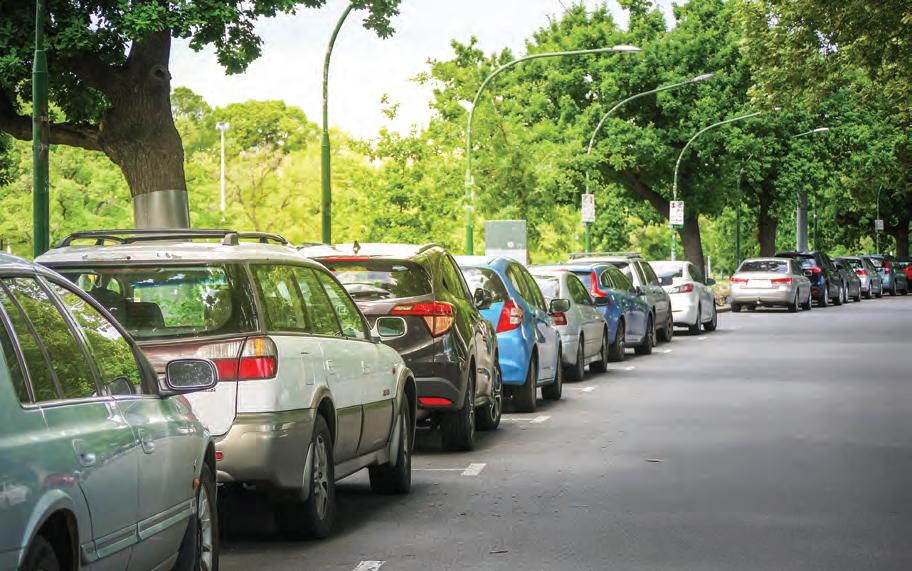


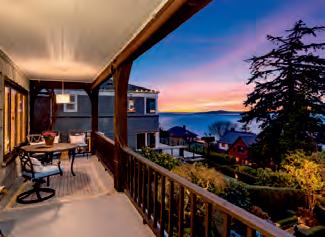


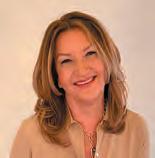


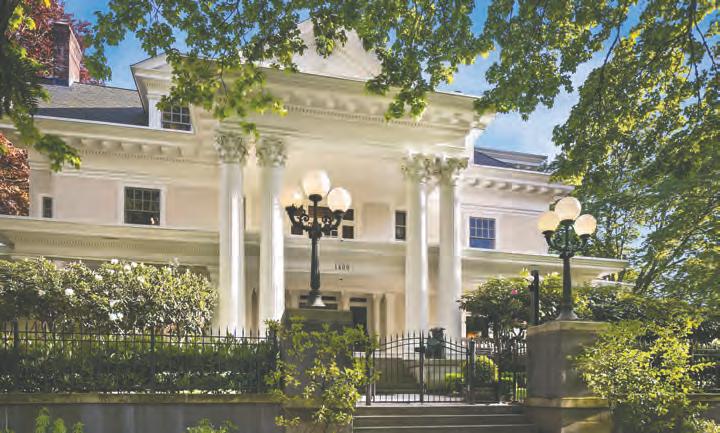

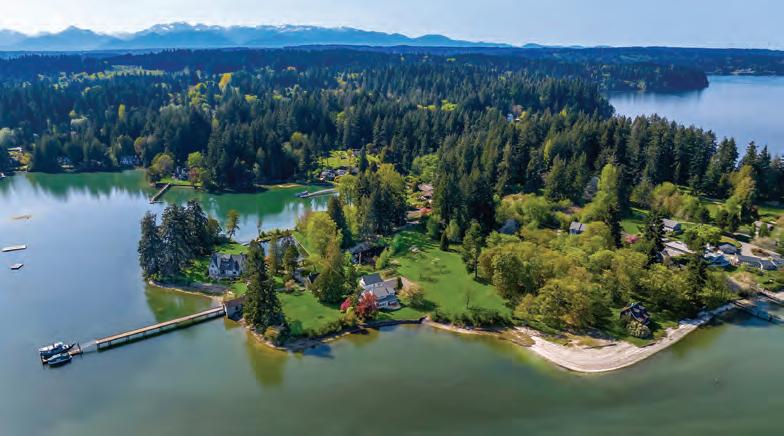





By Spencer Pauley }
Seattle Mayor Bruce Harrell said that he will soon announce a property tax levy renewal ballot measure with funding dedicated to the city’s youth.
During Harrell’s State of the City address on Tuesday, he said he will provide details on his proposed renewal of the city’s Families, Education, Preschool, and Promise Levy, or FEPP, sometime next month.
The current FEPP is a seven-year levy totaling $619 million. It is set to expire at the end of this year. It has a rate of $0.37 per $1,000 of assessed value. The median Seattle homeowner is estimated to pay approximately $327 this year for the levy.
Harrell said the wordy "levy" has changed over the years as a result of impacts from the COVID-19 pandemic. This includes utilizing levy resources to maintain K-12
programming and post-secondary programming through the 2025-2026 school year.
“This levy has changed and adapted over the years, which it should,” Harrell said in his state of the city address. “The name is now a lot of words to describe a simple vision: to make this a city that embraces and supports young people – from cradle to career.”
The mayor hinted that his upcoming proposal would focus generated funding more on childcare in the city, which is noted as a priority by the city as costs for families continue to be expensive.
The city council must adopt the proposal by summer in order for it to appear on the ballot this November.
If passed by voters, generated revenue from the levy renewal would help add more
hours of childcare and after-school care near Seattle elementary schools to provide relief for working parents.
Harrell points to the Seattle Preschool Program, which is funded by the current FEPP levy and focuses on developing preacademic skills for Seattle’s younger children. According to Harrell, that program is now nationally recognized and serves 2,500 kids across 98 classrooms.
“We must bring that same boldness to childcare – Seattle can be a national leader in this regard – to get kids off on the right foot, support working families, and keep Seattle on the rise with a new generation,” Harrell said.
Other initiatives the levy would fund if passed include additional in-school health centers and boosted security staffing and violence prevention in and around schools.
From page 1
needlessly drive up the cost of development,” according to the bill, “discourage walking and multimodal transit usage, and encourage excessive reliance of automobiles with attendant impacts on human health and greenhouse gas emissions.”
Bateman’s proposal would also apply to commercial spaces. She said the current law requires typical retail stores to provide more parking than the actual building. If approved, SB 5184 would stop cities from mandating more than one space per 1,000 square feet of commercial space.
The bill also prohibits minimum requirements for “existing buildings undergoing a change of use, including vacant buildings; residences under 1,200 square feet; commercial spaces under 5,000 square feet; affordable housing; senior housing; housing for people with disabilities; facilities that serve alcohol, child care facilities, [and] commercial spaces in mixed-use projects.”
However, the bill would not apply to parking spaces required by the Americans with Disabilities Act or areas within a mile radius of airports with at least 9 million annual passengers boarded. It also wouldn’t cap the parking developers can provide, meaning they get to decide.
Republican attempts to limit the bill to cities with at least 225,000 people failed. Only Seattle and Spokane would surpass that threshold, but Tacoma is only a few thousand away. The Senate passed SB 5184 with bipartisan support in a 40-8 vote.
“You’ll see on our side, there will be a mix because we have different cities,” Sen. Keith Goehner, R-Dryden, said of his dissenting peers, “but I believe this is a good step forward.”




“Laura is the grand dame of Broadmoor Realtors and truly an exemplar amongst brokers. We actually never considered anyone else after she brought us, years ago, an off-market offer within 24 hours when we made a contingent offer on another house. There truly is no substitute for Laura’s years of experience, constellation of relationships, meticulous attention to detail, keen design eye and, frankly, elegance and gravitas. She is intelligent, strategic, and incredibly efficient. We have absolutely zero reservations about recommending Laura and in fact, words really do not exist for how very much we appreciated the privilege of working with her.” – Norman & Mito






By Spencer Pauley
Center Square
A popular hiking trail along the Snoqualmie River has been closed indefinitely amid cuts to the U.S. Forest Service Agency.
A recent social media post showed a sign at the entrance of the Franklin Falls Upper Trailhead stating that both the Franklin Falls and Denny Creek trailheads are indefinitely closed due to “large-scale termination of Forest Service employees.”
According to the Washington Trails Association, President Donald Trump’s administration began the termination of approximately 1,000 National Park Service and 3,400 U.S. Forest Service employees across the country on Feb. 13. This is the second time the Forest Service saw cuts to its staffing in the last six months.
The Washington Trails Association said that the fired Forest Service employees are in charge of essential services to keep trails and campgrounds safe. This includes building and maintaining trails, responding to emergencies, and managing campgrounds.
“Eliminating these roles will directly impact the quality and accessibility of outdoor recreation – many of these people work on wildfire crews during the height of the wildfire season,” the association said in a statement. “The loss of these individuals will be felt for years to come.”
Washington leaders are also voicing their concerns with the mass firings of forest service employees.
In social media posts, U.S. Sen.
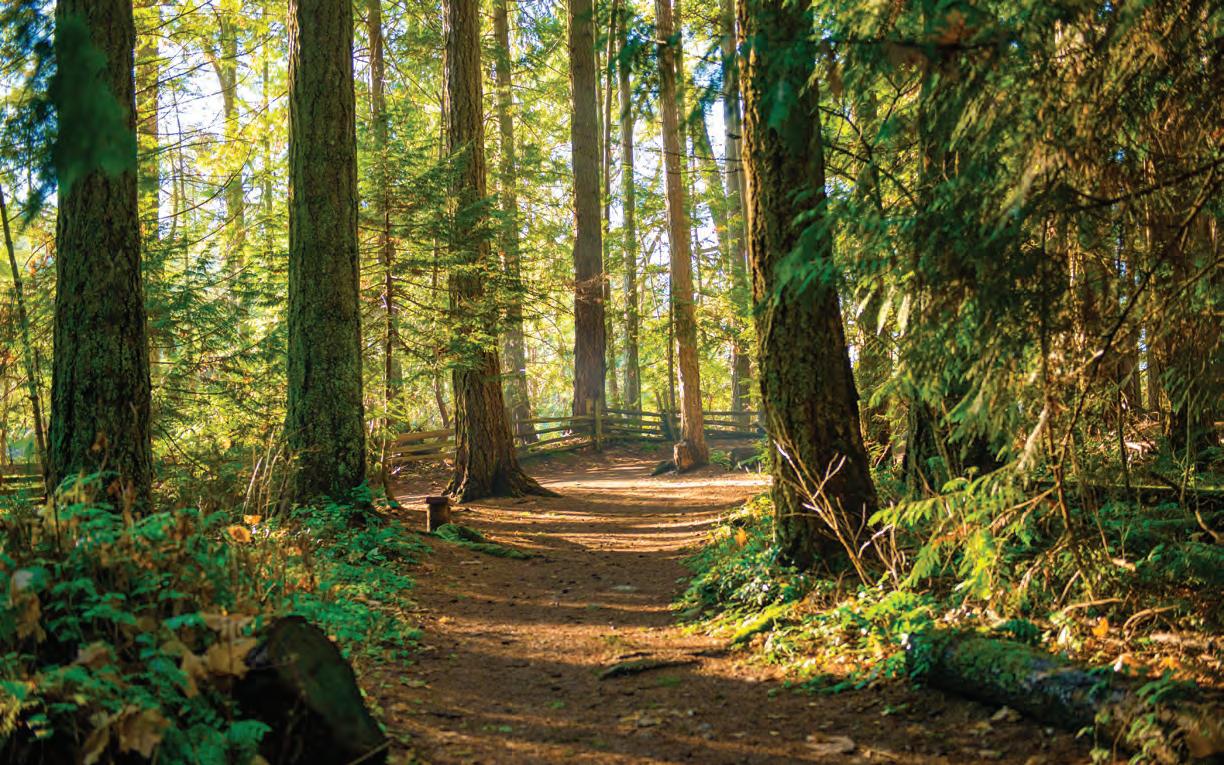
Kim Schrier, D-Wash., called Trump’s decision to fire thousands of U.S. Forest Service employees “pathetic” and pointed out that the firings lead to trailhead closures that “hurt the community.”
On Wednesday, fired employees joined U.S. Sen. Patty Murray, D-Wash. in a press conference




explaining how their firings are going to lead to negative impacts on the state.
Gregg Bafundo, a wilderness ranger from Okanogan County, was laid off from the Forest Service last week. Bafundo said the firings will lead to loss of lives and property. The belief is that remaining
employees will have to overwork to fill in the gaps in services left by the laid off workers.
The Trump administration has been working to downsize the federal workforce as part of its plan to get spending under control. The Department of Government Efficiency has reported that it has saved American taxpayers $55 billion so far in 2025 with cuts to federal departments.
The Center Square reached out to the U.S. Forest Service agency to confirm it placed the sign at the Franklin Falls trailhead, but did not receive a response by the time of publication.






























bout mid-March, the annual explosion of spring blossom will begin in Seattle. Until that time (and it will come quickly) we’ll still be thinking about color and beauty for the winter garden. So before the curtain comes down on the Jack Frost Show, let’s have one more look at a plant to enliven our gardens in the dark months.




Mexican Orange (Choisya ternata) has been around a long time, working hard, so well, so long, so steadfastly, that it is taken for granted. But if you were strolling the sidewalks of Madison Park during the brutally cold days of last month, and you saw a burst of lustrous sunshine yellow foliage, you might well have been looking a Choisya ternate “Sundance.” When other broad-leafed evergreens were drooping and looking quite forlorn in the shivering temperatures, this spirited shrub seemed to be basking in the chill. It will withstand a prolonged drop in temperatures to 15 degrees. The plant forms a dense mound, up to 6 feet tall. The leaves are near the ends of branches and are divided into fans of three leaflets, each as long as 3 inches. In Spring, clusters of fragrant white flowers emerge, somewhat like orange blossoms. The flowering is continuous for a couple of months and then, intermittently through the summer. Branches, in or out of flower, are a delight to take indoors for leaf color or blossom scent. The flowers are especially attractive to bees and butterflies. The common name refers to the flowers. There is no fruit.
Native to Northern Mexico and Arizona, this plant seems to thrive better here than it does in its native habitat. It prefers acid soil, which we have in ample supply. While it needs full Sun, it sometimes scorches in the desert heat. Here, our gentle summers keep the foliage lush and upright. Give it a spot where it can soak up sunlight and take command of the space. Some gardeners recommend it as a good hedge plant. It is, because in takes to shearing and leafs back freely, but this writer and gardener cannot bring himself to chop at the easy going form of this naturally round, symmetrical shrub. Given a large enough container, it could also make a very impressive pot plant, given you have plenty of space for it.
Buy a plant now, in a one-gallon can. You can put it in the ground immediately this month. Dig a generous hole, more than twice as wide as the container the plant comes in and deep enough that the top of the root ball is just a bit below the ground level. Loosen the rootball when you take it out of the nursery container. Fill the planting hole with water, thrice, letting it soak in, fully, between fillings. Put the Mexican Orange in place, fill-in with good, loam, water again and top with a mulch. You’ll likely not have to water again until Summer parches the garden.
For Winter foliage color, a year-round mound of sunshine in the garden, and for delicate, sweetly fragrant flowers, Mexican Orange stands alone. Muy hermosa y trabajadora! Ole!
By MetroCreative
(Ten Speed Press) allows home chefs to bring a taste of Vietnam into their homes.
CHICKEN AND VEGETABLE CLAY POT RICE
Serves 3 or 4
■ ½ teaspoon salt
■ ¼ teaspoon white pepper
■ ½ teaspoon sugar
■ 2 teaspoons light (regular) soy sauce
■ 2 tablespoons oyster sauce
■ ¾ pound boneless, skinless chicken thighs, cut into 1/2-inch cubes
■ 5 tablespoons canola or other neutral oil
■ 1 small yellow onion, finely chopped
■ 2/3 cup chopped celery (peasized pieces)
■ 2/3 cup chopped carrot (peasized pieces)=
■ 5 to 6 dried shiitake mushrooms, reconstituted, trimmed and chopped into pea-sized pieces
■ ½ cup frozen peas, preferably petite peas, thawed
■ 2 cups long-grain rice
■ 2 2/3 cups chicken stock
1. In a bowl, stir together the salt, white pepper, sugar, soy sauce, and oyster sauce. Add the chicken and use chopsticks to mix well. Set aside.
2. In a large skillet, heat 2 tablespoons of the oil over medium heat. Add the onion and saute for

about 1 minute, or until fragrant. Add the celery, carrot and mushrooms and continue to saute for about 3 minutes, or until half cooked. Add the chicken and saute gently for 3 to 4 minutes, or until the chicken is cooked through. Remove from the heat, stir in the peas and set the pan aside.
3. Rinse the rice and let it drain for 10 minutes in a sieve positioned over a bowl. Meanwhile, bring the stock to a near simmer in a small saucepan and then cover to keep it hot.
4. In a heavy-bottomed 5-quart Dutch oven or similar pot, heat the



remaining 3 tablespoons oil over medium-high heat. Firmly shake the sieve, holding the rice to expel any water, and then add the rice to the pot. Stir constantly with a large spoon for about 3 minutes, or until the grains are opaque and feel light. Add the stock and expect dramatic boiling. Immediately give the rice and stock a big stir, then lower the heat to medium so the contents simmer and cover the pot. Put your ear by the pot and you will hear gentle bubbling.
5. During the next 5 minutes, encourage the grains to absorb the stock and cook evenly. To do
this, periodically remove the lid, give the rice a big, quick stir, and then replace the lid. Stir the rice 3 times, usually about 30 seconds after the steam plumes begin shooting from under the lid. The rice will first swim in stock and then progressively become less easy to move. Small craters will form on the surface, too. When you stir the third time, the rice should stick a bit to the pan and most of the stock will have been absorbed.
6. Uncover and add the vegetables and chicken and any juices from the skillet, distributing them evenly over the rice. Replace the


lid and continue cooking for 10 minutes longer. Uncover and stir the contents, scraping the bottom to combine all the ingredients. Replace the lid, remove from the heat and let the rice sit for 10 minutes to allow the flavors to meld.
7. Fluff the rice with chopsticks or a fork and then spoon it into 1 or 2 serving bowls or platters. If a little crust has formed on the bottom of the pot, scoop it out and serve the shards separately for anyone who enjoys the crisp, nutty taste.

